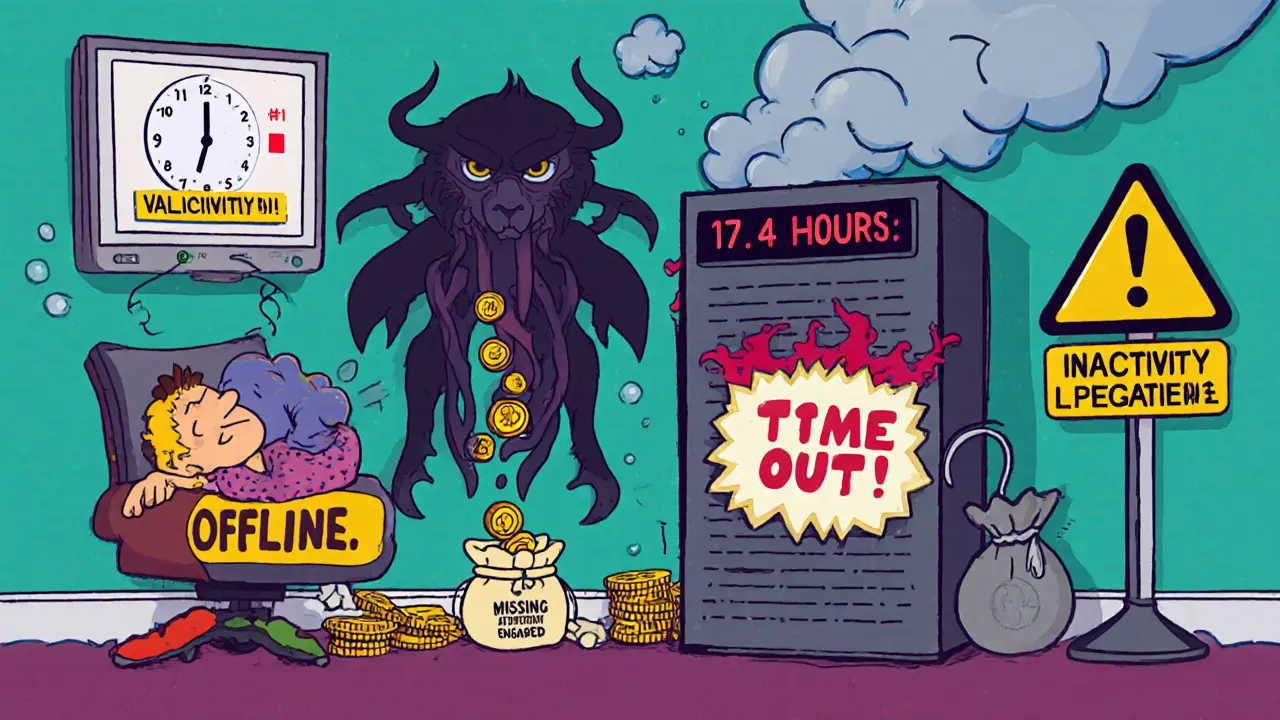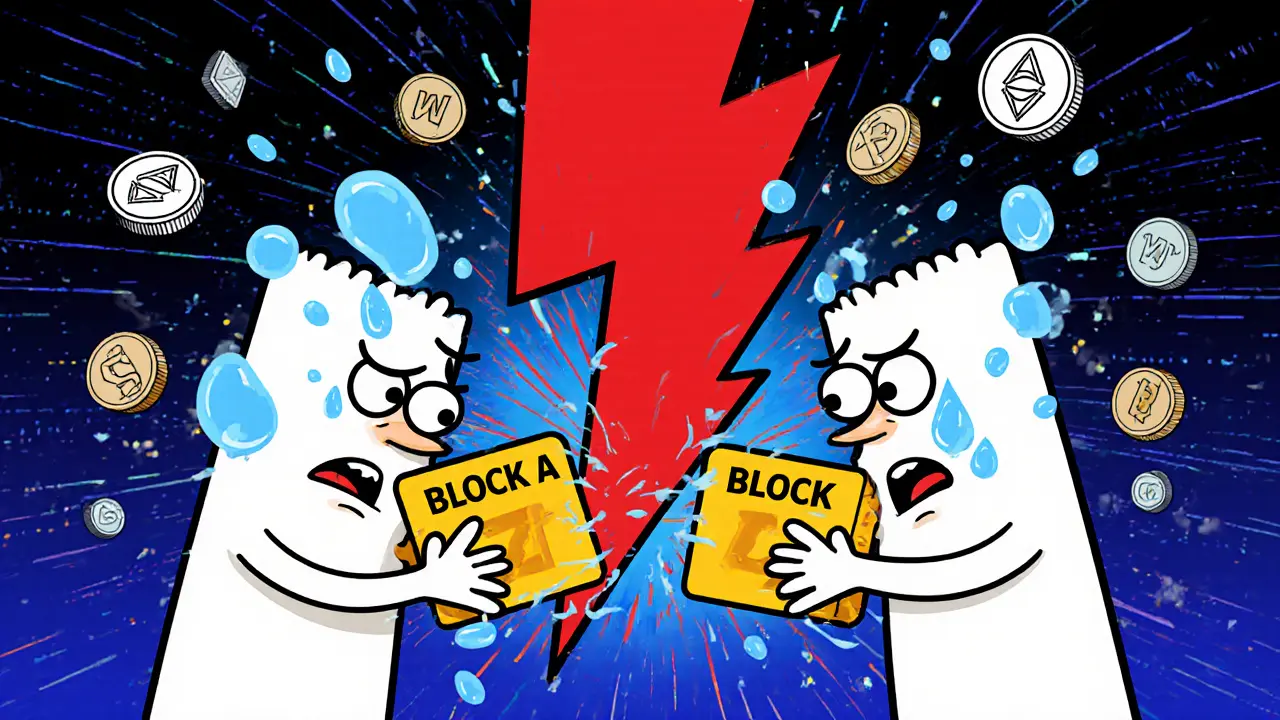Getting slashed in a proof-of-stake (PoS) blockchain isn’t a glitch-it’s a feature. If you’re staking ETH, ATOM, DOT, or any other PoS token, you’re playing a high-stakes game where one misstep can cost you hundreds or even thousands of dollars. Slashing isn’t punishment for being bad-it’s designed to make cheating or negligence too expensive to even consider. But here’s the thing: most people who get slashed didn’t try to break the rules. They just didn’t know what to watch out for.
What Slashing Actually Means
Slashing is when the network automatically takes away part of your staked tokens because you broke a rule. It’s not manual. It’s not a judge deciding. It’s code. And it’s triggered by specific actions-or failures to act-that threaten the network’s security.
Think of it like car insurance. If you drive recklessly, your rates go up. If you cause an accident, you pay. Slashing works the same way: if you act in a way that could compromise the blockchain, you pay a penalty. The goal isn’t to scare people away-it’s to make sure everyone plays fair. Without slashing, validators could lie, double-sign blocks, or go offline without consequence. The network would collapse.
The Two Big Reasons You Get Slashed
There are only two types of violations that trigger slashing: safety violations and liveness violations. One is deadly. The other is sneaky.
Safety Violations: Double-Signing
This is the worst thing you can do. Double-signing means you signed two different blocks at the same height. It’s like telling two different versions of the truth at once. In a blockchain, that creates a fork. That’s dangerous. It can lead to double-spending or chain reorganizations.
Ethereum slashes you for this with a minimum of 1 ETH-plus more if other validators are getting slashed at the same time. Cosmos doesn’t just take your stake-they tombstone you. That means you’re permanently banned from validating again. Polkadot hits you with up to 30% of your stake. ZetaChain takes 5%. No one messes around here.
How does this happen? Usually, it’s because you ran two validator clients on the same key. Maybe you copied your setup to a backup server and forgot to disable the original. Or you restored a snapshot from an old backup and started it up again. One client thinks it’s the only one. The other doesn’t know it’s a duplicate. Boom. Double-sign. Slashed.
Liveness Violations: Going Offline
This one catches people off guard. You didn’t do anything malicious. You just didn’t show up. Your validator went offline. Maybe your server crashed. Your internet went down. Your power failed. Your NTP clock drifted. Your software updated and didn’t restart.
On Ethereum, if you miss attestations for too long, you start losing rewards. After about 17.4 hours of inactivity, you enter what’s called an “inactivity leak.” Your stake slowly drains until you’re back online. It’s not slashing at first-it’s a penalty. But if you stay offline for weeks, you can lose 10%, 20%, even 30% of your stake. That’s not a typo.
On Cosmos, you get a 0.01% penalty after 10,000 consecutive missed blocks. That sounds small. But if you’re staking 10,000 ATOM, that’s 1 ATOM gone. If you’re staking 100,000 ATOM? 10 ATOM gone. And if your node stays down for days? You’re looking at hundreds of dollars.
What Actually Causes These Violations?
It’s not magic. It’s not bad luck. It’s usually something you could have prevented.
Client Misconfiguration
Running a validator isn’t like running a website. You need three separate pieces: an execution client (like Geth), a consensus client (like Lighthouse or Prysm), and a validator client (like validator-cli). All three must talk to each other perfectly. If one is misconfigured-say, you pointed the consensus client to the wrong RPC endpoint-you’re running blind. You won’t know when to sign. You’ll miss attestations. You’ll get slashed.
According to Stakin’s 2023 report, 34% of slashing incidents come from this exact problem.
Time Sync Issues
Blockchains rely on precise timestamps. If your server clock is off by even a few seconds, your validator might think it’s too early or too late to sign. Ethereum validators must be within 15 seconds of network time. Most people use NTP (Network Time Protocol) to sync. But if your NTP server is slow, blocked, or misconfigured? Your node goes silent. And silence gets punished.
One validator in February 2023 lost 3.5 ETH because their NTP server was down for 48 hours. They didn’t even realize it until they got the slashing notice.
Key Management Mistakes
Your validator key is your digital signature. If you back it up wrong, share it accidentally, or store it on a cloud drive that gets compromised? You’re asking for trouble. Some people copy their validator key folder to a USB stick, then plug it into a laptop that gets infected with malware. The malware steals the key. Someone else uses it to double-sign. You get slashed.
And yes-this has happened. More than once.
Software Updates Gone Wrong
Ethereum upgrades every few months. Cosmos updates every 2-3 weeks. Polkadot rolls out runtime upgrades constantly. If you don’t update your clients on time, your node gets out of sync. It stops producing attestations. It gets slashed.
Worse, if you update but don’t restart your services properly? You’re running an old version in the background. The new version thinks it’s running. It’s not. You’re offline. Slashed.

How Much Can You Lose?
It depends on the network, the violation, and how many others are getting slashed at the same time.
| Network | Double-Signing Penalty | Downtime Penalty | Additional Risk |
|---|---|---|---|
| Ethereum | Minimum 1 ETH + up to 100% of stake | Gradual inactivity leak (up to 30% over weeks) | Coordinated slashing can multiply penalties |
| Cosmos | 5% + tombstoning (permanent ban) | 0.01% after 10,000 missed blocks | No recovery after tombstoning |
| Polkadot | 0.1% to 30% depending on severity | Variable, based on network health | Collective slashing hits everyone during outages |
| ZetaChain | 5% | 1% per downtime event | Three violations = permanent removal |
In April 2022, a bug in the Prysm consensus client caused 275 Ethereum validators to get slashed at once. They lost a combined 1,000 ETH-worth $2.8 million at the time. That wasn’t because they were malicious. It was because they were all running the same flawed software. The network punished them all equally. That’s how slashing scales.
How to Avoid Getting Slashed
You don’t need to be a coder. You don’t need to be a genius. You just need to be careful.
- Use monitoring tools. Set up alerts for your validator. Use services like validators.watch, beaconcha.in, or Blocknative. If your node goes offline, you should get a text, email, and Telegram message-not a slashing notice.
- Run redundant nodes. Don’t rely on one server. Run a backup on a different cloud provider (like AWS and Linode). If your main server dies, the backup picks up. One validator on Cosmos avoided slashing by doing exactly this after an ISP outage.
- Test your failover. Once a month, shut down your main node and see if the backup kicks in. If it doesn’t, fix it before you get punished.
- Update before the upgrade. Don’t wait for the day of the upgrade. Test new clients on a testnet first. Read the release notes. Follow the official guides.
- Never share your validator key. Keep it offline. Use a hardware wallet if possible. Don’t store it in Dropbox, Google Drive, or GitHub.
- Sync your time. Use a reliable NTP server. Check your clock weekly. If you’re on Linux, run
timedatectl statusand make sure it says “NTP synchronized: yes.”
And if you’re new? Spend 87 hours learning. That’s the average time it takes for a validator to fully understand slashing risks, according to Everstake’s survey. Don’t rush. Don’t guess. Read the Ethereum Foundation’s Staking Launchpad. Watch videos from Consensys Validator Academy. Join r/ethstaker. Ask questions. The penalty for ignorance is way higher than the cost of learning.

The Bigger Picture
Slashing isn’t just about punishing bad actors. It’s about creating a market for reliability. Validators who run stable, secure nodes earn more. Validators who cut corners lose. Over time, the best operators rise to the top. The network gets stronger.
But there’s a dark side. When slashing is too harsh, small validators get pushed out. Only big players with teams, redundancy, and budgets can survive. That’s why some experts warn against overly aggressive penalties. The goal isn’t to centralize staking-it’s to secure it.
That’s why Ethereum is lowering its minimum penalty from 1 ETH to 0.5 ETH in the upcoming Dencun upgrade. Why Polkadot is testing slashing insurance pools. Why new chains are building in more forgiving grace periods.
Slashing is here to stay. But it’s getting smarter.
Final Reality Check
As of November 2023, Ethereum has recorded over 1,400 slashing incidents. 68% were due to double-signing. 27% were from inactivity. The rest? Human error.
You won’t get slashed if you’re careful. You won’t get slashed if you’re prepared. But if you treat staking like a passive income stream-like putting money in a savings account-you’re already one mistake away from losing thousands.
Slashing isn’t the enemy. Complacency is.
Can you get slashed for just going offline?
Yes. While going offline doesn’t always trigger immediate slashing, prolonged downtime leads to inactivity leaks on Ethereum, which slowly drain your stake. On Cosmos, missing 10,000 consecutive blocks triggers a 0.01% penalty that adds up over time. If you’re offline for weeks, you can lose 10-30% of your stake.
What’s the most common cause of slashing?
Double-signing is the most common cause, accounting for 68% of all slashing incidents on Ethereum. This usually happens when a validator runs two clients with the same key-often due to misconfigured backups or failed software updates.
Can you recover after being slashed?
On most networks, yes-you can keep validating after a penalty. But on Cosmos, double-signing leads to tombstoning, which permanently removes you from the validator set. You’d need to re-delegate and start over. Ethereum and Polkadot allow you to continue, but you’ll need to re-stake any lost funds.
Is slashing the same across all blockchains?
No. Ethereum uses dynamic penalties that increase if many validators are slashed at once. Cosmos uses fixed penalties plus permanent bans for double-signing. Polkadot scales penalties based on severity and whether the failure was isolated or widespread. Each network designs slashing to match its security goals.
Do I need to be a technical expert to stake safely?
You don’t need to be an expert, but you do need to be disciplined. Most slashing incidents come from preventable mistakes: misconfigured clients, outdated software, or poor time sync. If you follow best practices-monitoring, redundancy, and updates-you can stake safely without writing a single line of code.
What’s the safest way to start staking?
Start small. Use a trusted staking service like Coinbase or Kraken if you’re unsure. If you want to run your own node, use the Ethereum Foundation’s Staking Launchpad. Follow their checklist. Run your first validator with only 1 ETH. Learn the ropes before risking more. Most experienced validators started exactly this way.
What’s Next?
If you’re already staking, check your validator status right now. Use beaconcha.in for Ethereum or cosmoscan.io for Cosmos. Are you online? Are your alerts working? Have you updated your clients this month?
If you’re thinking about staking, don’t rush. Read the documentation. Watch a tutorial. Join a community. Slashing isn’t scary if you know what you’re doing. But it’s devastating if you don’t.
The blockchain doesn’t care if you’re new. It doesn’t care if you’re busy. It only cares if you follow the rules. And the rules are clear: stay online. Don’t double-sign. Update on time. And never, ever share your key.
